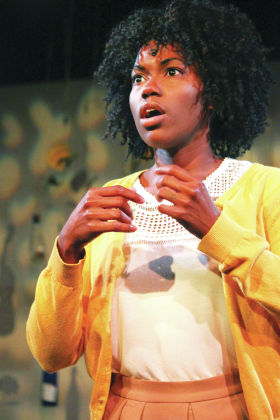
In the context of a linear plot, it would be called a "soliloquy"—like when Hamlet (or the King of Siam, for that matter) stops to mull over his next course of action. In The Inside, Lydia R. Diamond, however, dispenses with the frame altogether to base her entire play within the consciousness of a young artist—identified only as "Emma"—who surveys the participants of a party and wonders, "What am I doing here?"
Emma's alienation doesn't stem from her being the sole African-American girl at this gathering of elite north-suburban university students. ("They're white," she observes, generously adding, "They can't help it.") Nor is it because her lineage encompasses three generations of scholars leading to her upbringing within high-profile academic environments. It's not even the handsome and likewise solitary African-American male guest who pretends he doesn't see her and whom her hostess pretends she can't identify by his ethnicity.
No, what sparks our pilgrim's existential mini-crisis is the realization that her peers are a bunch of hicks—well-dressed, pampered and pedigreed hicks, to be sure, but baby fish paddling in a nursery pond, nevertheless. Spurred by faux-rustic decor and fashionably exotic provender, the "white noise" generated by children of affluent parents lamenting the oppressive burden of privilege, or yearning to live in a "real" neighborhood among "real" people (as long as it's safe and not too expensive), suddenly gives way to hints of racism no less annoying for being unintentional.
Diamond's first-person narrative sometimes lapses into the abstract artspeak her persona deplores but allows her to take notice of small insecurities immediately and universally recognizable—how to discreetly check whether your deodorant has ceased functioning (and what would you do if it had?), how being unable to find the bathroom for the crowds in the hall triggers flashbacks of early schooldays and how being both "inside" and "outside" a community makes for divided loyalties even as it rejects the comfort of easy stereotypes.
The music of Red Clay (featuring Reggie Lawrence on jazz guitar) contributes a gently lulling soundscape to locate us in our rarified surroundings, but the evening belongs to Kristin E. Ellis, who engages the audience—sometimes on their own turf—with articulate insight for a full 90 minutes devoid of stumbles, hesitations or pauses for rehydration. The results not only encapsulate a milieu nowadays all but lost to nostalgic memory, but offer a glimpse of the author's cosmological indecision in the years before she became the celebrated playwright we know today.
